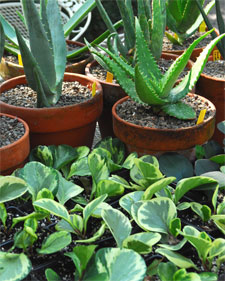From the Sperry Garden – September, 2008
Prime Time For Plant Propagation

If you ever wanted to start your own plants, late September/early October is one of the best times of the entire year to do so. Let’s look at some of the specific opportunities.
Division. The old axiom with perennials is that "If it blooms in the spring, you dig and divide it in the fall, and, vice-versa." Violets and iris are the first perennials that await your nursery spade in the next couple of weeks. Daylilies, Shasta daisies, oxalis and hardy amaryllis follow soon on the heels. Each of these plants establishes itself as a colony, or "clump" of plants. Over the years, the clumps become crowded, to the detriment of the entire planting. If you’re going to succeed long-term with these plants, you’ll have to dig and divide them every few falls. I’ve already started doing so in my landscape.
Work when the garden soil is moist, but not when it’s soggy. Use a sharpshooter or flat-bladed nursery spade to lift the entire clump up and out of the ground. Use your hands to break or pry the mass into individual plants (or, at least into smaller clumps). Tightly rooted plants may have to be split with the blade of the spade. Set the plants aside as you rework their planting bed thoroughly. Turn or rototill 4 to 5 inches of organic matter (Canadian peat moss, bark mulch, compost, rotted manure) and 1 inch of expanded shale into the top foot of soil. Remove all weeds and their roots in the process.
As you replant your smaller clumps of perennials, space them at the recommended distances. Your first inclination would be to use all of the plants, but that’s a bad plan. Your plants will soon be overcrowded, and you’ll be right back where you started. Use the opportunity to start new beds elsewhere in your landscape or to give extra plants to friends.
For the record, some of our more popular houseplants can also be started by division. Bromeliads and clumping succulents such as sansevierias, aloes and haworthias can be divided, and so can most ferns. All it takes to divide a plant is a clumping, generally stem-less, plant form.
Division isn’t a rapid way to increase populations of your favorite perennials, but it’s steady and dependable. You’ll be amazed at how quickly you’ll have good numbers, and this is the time to get the ball rolling.
Cuttings. There’s an inherent difference between dividing a plant and taking cuttings, and that difference is that divisions have roots intact. Cuttings have to survive long enough to develop new roots. Nurserymen do most of their cutting propagation of woody stock in late spring and early summer, but they have mist systems in their greenhouses. Home gardeners take more cuttings in the fall. It’s still warm enough for cuttings to develop roots quickly, yet it’s not so hot that the cuttings might wilt and die before they can take hold.
If there are annuals that root easily from cuttings, and especially if they’re plants that are hard to find in nurseries, cuttings are a good way of keeping the strain alive over the winter. Remember that you have limited sunny windowsill space, so save only those types that you can’t easily or affordably replace in the spring. Fancy-leafed and other unusual begonias fit that description, as will particular varieties of coleus.
I’ve been amazed at how rapidly some peperomia cuttings I took several weeks ago have developed good roots. I’ve followed them up with more cuttings of devil’s backbone (Pedilanthus).
As you stick your cuttings, use a very loose, highly organic potting mix. Many propagators use equal amounts of Canadian peat moss and horticultural grade perlite. I mix in 10 to 20 percent expanded shale if I need more weight or better aeration. Take cuttings from healthy new growth. Depending on the type of plant, your cuttings will usually be 3 to 4 inches long. Unless you’re dealing with woody plants in a greenhouse propagation bench, there’s probably no need to use rooting hormone powder for succulent annuals.
You’ll know your cuttings have started to form new roots when they offer resistance to gentle tugs. At that point, you can plant them into small pots filled with a quality, lightweight potting soil. Let them become established outdoors as long as the weather permits, then move them inside before the first killing freeze.

